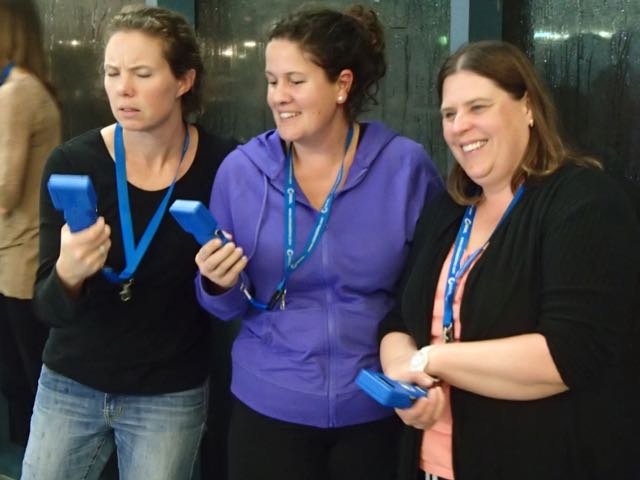“How accurate is Olly Timing?” is the question that every diligent swimming person asks us.
Swimming NSW had the same question and kindly offered the opportunity for us to validate Olly Timing at 2 of their meets. Olly Timing successfully recorded 6,422 times over 33 hours of operation at these 2 meets.
Here are our results.
Spoiler alert – it’s accurate!
Olly Timing has a similar accuracy to human timekeepers. We actually found that the largest “inaccuracies” occurred when the Official time was clearly incorrect.
Olly Timing makes swimming more sustainable
Competitive swimming is extremely popular, yet the sport appears to be struggling to meet demand due to constraints in volunteer and venue availability, and the decline of traditional funding models.
The most volunteer intensive activity in our sport is timekeeping because it typically requires 20+ people fulltime at a large venue. Olly Timing can remove that constraint.
For example, Swimming Victoria removed timekeepers from pool deck at their 2023 Age LC Championships. This eliminated approximately 600 parent timekeeping shifts representing 4 person months of effort.
Reducing the timekeeping burden will enable Technical Officials to focus entirely on the swimmers.
An alternative to human timekeepers
Olly Timing is designed as an alternative to human timekeepers at State level events and below. It uses Artificial Intelligence (AI) powered computer vision technology to deliver accurate and reliable swimming competition timing without timekeepers.
Since 2020 Olly Timing has been in development in collaboration with Sydney University, Hawk-Eye Innovations, the Australian Sports Technologies Network, Swimming Victoria, Swimming NSW and Swimming Metro North East.
Operates stand alone or alongside touchpad systems
Olly Timing is operated either stand alone, to record all event times (similar to Dolphin Timing) or to provide backup times alongside a touch pad system, (such as Quantum). Results are delivered via a recorder scoreboard, and/or electronically into Meet Manager software.
Trained humans ensure accuracy
During operation, timing triggers automatically at the starting signal. At each lane finish Olly initially records times automatically via its proprietary AI algorithm. These are then swiftly reviewed and adjusted manually by a human operator to ensure accuracy. These manual times are valid, not the automatic ones.
To ensure accuracy and good service, Olly Timing is operated by trained staff. The training syllabus includes a key operating practice for High Speed Video (HSV) timing used at Swimming Australia meets – that the point of pressure, not point of initial touch, is chosen as the finish time.
Everything is recorded and available for review
To ensure resilience, Olly Timing continuously records the entire competition. This backup is easily accessible to review past events and recover from any failures.
Olly Timing has been refined through thousands of hours of development and testing at a variety of pools. To date, it has been successfully used to record 9,201 times over 52 operational hours at 6 swim meets.
33 hours of validation testing
Validation testing was performed at the entire SNSW Country Swimming Championships 16-18 Feb 2024, and day 1 of Metro 25th Feb, at the kind invitation of SNSW.
Olly Timing was operated in parallel with Quantum to assess its accuracy and consistency relative to human timekeepers.
| Country | Metro | Total | |
| Hours of operation | 25 | 8 | 33 |
| Times recorded | 5,084 | 1,388 | 6,422 |
Human timekeepers were used as a baseline
There were usually 2 timekeepers per lane during Country and Metro. This is confirmed in Chart 1 which shows that for 5,327 (83%) of races at least 2 lane buttons were pressed.

Differences between these timekeeper backup times and the official times are shown in Chart 2.

The distribution has a mean of 0.05s and Standard Deviation of 0.07s. We believe that the mean slightly above 0 reflects the human reaction time delay between the swimmer finishing and button being pressed.
These results will slightly overstate the accuracy of timekeepers because the official results include times where the timekeeper times were used as official. At Country, timekeeper times were used on 257/5084 (5.1%) of occurrences. In practice when these results were removed from the above analysis it made a negligible difference to the mean and standard deviation.
3 timekeepers per lane is ideal, but rare. These days it is increasingly common to have only 1 per lane. Accuracy analysis for a single timekeeper is shown in Chart 3.

The backup time accuracy has decreased, as shown by both the mean and standard deviation increasing. Note the dataset size is much smaller, but still valid.
Readers may be interested to compare these results with our July 2022 study of human timekeeper accuracy here.
How does Olly Timing compare?
Differences between Olly times and the official times are shown in Chart 4. Note this data excludes 3 swims adversely impacted by operator error. In a normal production environment these would have been immediately recognized and corrected.

The distribution has a mean of 0.00s and standard deviation of 0.09s.
We will now conduct more granular analysis.
Olly accuracy by stroke, distance and lane has been evaluated and the results shown in Table 2.
| Filter | n | Mean (s) | Standard Deviation (s) |
| Freestyle | 2450 | 0.01 | 0.09 |
| Butterfly | 1258 | 0.00 | 0.10 |
| Backstroke | 1179 | 0.00 | 0.10 |
| Breaststroke | 832 | 0.00 | 0.07 |
| Medley | 426 | 0.00 | 0.09 |
| 50m | 2357 | 0.00 | 0.09 |
| 100m | 2152 | 0.01 | 0.09 |
| 200m | 1596 | 0.00 | 0.09 |
| 400m | 218 | -0.02 | 0.08 |
| 800m | 44 | -0.04 | 0.08 |
| 1500m | 52 | 0.00 | 0.09 |
| Lane 0 | 563 | 0.00 | 0.09 |
| Lane 1 | 602 | 0.01 | 0.09 |
| Lane 2 | 659 | 0.01 | 0.08 |
| Lane 3 | 719 | 0.01 | 0.08 |
| Lane 4 | 718 | 0.01 | 0.08 |
| Lane 5 | 714 | 0.00 | 0.08 |
| Lane 6 | 676 | 0.00 | 0.10 |
| Lane 7 | 642 | 0.00 | 0.10 |
| Lane 8 | 594 | 0.00 | 0.09 |
| Lane 9 | 532 | 0.00 | 0.10 |
There is very little variation between segments. Breaststroke is marginally more accurate than other strokes due to the visibility of the final touch. Butterfly and Backstroke are marginally less accurate due to the amount of splash and obscured touches respectively.
To check for statistically small but potentially systematic issues, outlier analysis has been conducted on Olly Times greater than 0.4s from Official by stroke, distance and lane. The results are shown in Table 3.
| Filter | Number of occurrences | Proportion of times (%) |
| Freestyle | 13 | 0.53 |
| Butterfly | 8 | 0.64 |
| Backstroke | 9 | 0.76 |
| Breaststroke | 0 | 0.00 |
| Medley | 3 | 0.70 |
| 50m | 11 | 0.47 |
| 100m | 12 | 0.56 |
| 200m | 8 | 0.50 |
| 400m | 1 | 0.46 |
| 800m | 0 | 0.00 |
| 1500m | 0 | 0.00 |
| Lane 0 | 3 | 0.53 |
| Lane 1 | 3 | 0.49 |
| Lane 2 | 2 | 0.30 |
| Lane 3 | 3 | 0.42 |
| Lane 4 | 3 | 0.42 |
| Lane 5 | 1 | 0.15 |
| Lane 6 | 7 | 1.09 |
| Lane 7 | 3 | 0.47 |
| Lane 8 | 2 | 0.34 |
| Lane 9 | 5 | 0.94 |
The only points worthy of deeper investigation are Lane 6, and to a lesser extent Lane 9.
- Lane 6: Later analysis (refer to Table 5) shows that Lane 6 has the highest backup time usage rate by some margin at Country. This means that many more official times are from timekeepers in that lane, and we already know that timekeeper times differ from touchpad times. Hence it is no surprise that there is a greater number of Olly outliers on this lane.
- Lane 9: we believe that the slightly elevated number of outliers on this lane is because it appears at the edge of the video and image clarity is not quite as good compared with the middle lanes. The number and magnitude of outliers is insufficient for this to be concerning.
Accuracy conclusions
The above analysis has demonstrated that Olly Timing achieves a better mean, and the same or very slightly inferior standard deviation relative to human timekeepers, depending how many are used per lane. The numerical results are summarised in Table 4.
| Backup times (mostly at least 2 timekeepers per lane) | Backup times with 1 timekeeper per lane | Olly Timing | |
| Mean (s) | 0.05 | 0.06 | 0.00 |
| Standard Deviation (s) | 0.07 | 0.09 | 0.09 |
We therefore conclude that Olly Timing has a similar accuracy to human timekeepers. Swimming NSW and others agree.




